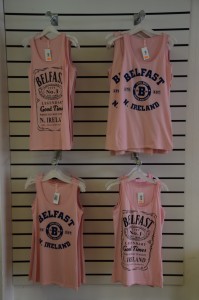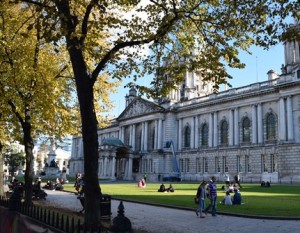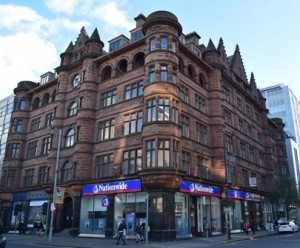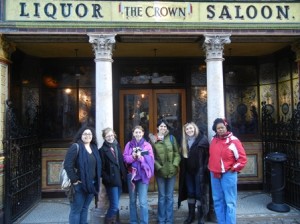18 The Belfast Miracle
Posted by Christine on Oct 24, 2014 in Ireland | 2 comments
I first visited Belfast, Northern Ireland, with my family in the early days of January, 1998—before the Good Friday Peace Agreement that came about later that year. A ceasefire had been in place for several years. Though the city’s resolute citizens tried to go about their lives in a normal way, the tension was palpable. Police cars that looked more like tanks roamed the streets, and almost every shop had its burly guard at the door. As an American you were forgiven for saying the wrong thing or asking an all too obvious question, but conversations were strained, filled with euphemisms and code words.
We stayed in the Europa Hotel, the “most bombed hotel in the world” because there so few hotels in the city and because we thought they were courageous to have stayed open throughout the Troubles and in spite of periodic damage to their premises. When we handed the keys of the rental car to the doorman for valet parking, he kindly suggested that we tuck out of sight the little Republic of Ireland tricolor flags we had given the kids in their Christmas stockings. “I don’t mind,” he said, “but someone might.”
I was there to figure out if Belfast should be on the itinerary of the student trip Linda Hubert and I were planning for the following year at Agnes Scott. To see the city, we went on a walking tour with a guide who at least made an attempt to hide his political allegiances. I was impressed with the variety of Victorian architecture, even more so when we learned that because of severe bombing during World War II, most of the buildings were completely new inside, retaining only the facades of the original structures. Imposing structures like City Hall, the Grand Opera House, Belfast Castle, and Stormont (current home of the Northern Ireland Assembly, but then housing the Civil Service) marked the city as a capital of politics and culture. I would have planned a trip only to see the beautiful Victorian Crown Liquor Bar and Saloon with its stained glass windows, snugs, and gas lamps. The Linen Hall Library was a revelation, an oasis of free thinking established during the enlightenment and determined to serve the intellectual interests of all citizens since then. The tall yellow gantries of Harland and Wolff shipbuilders—builders of the Titanic among other famous ships—gave the city’s industrial past a visible presence. Belfast sits in a valley with Belfast Lough to the east. I loved the way that when you looked down almost every street to the north, west, or south, you could see green hills in the distance.
Yet I could not find a post card, t-shirt, pencil, mug, or souvenir spoon with the word “Belfast” stamped on it. Other than our guide (he also had a “real” job), there was no evidence of tourism—no visitors center, no tourist maps, no helpful signage, no sense of pride in showing off the city to people from other places. Belfast had not yet awakened to its potential as a tourist and business destination, much less to its importance in defining Northern Ireland to the world. And no wonder, thirty years of the Troubles had left their mark. I knew the students had to see this city, though, and the signing of the peace agreement and ratification by over seventy percent of voters in Northern Ireland that spring made it easier to sell the idea to a few nervous parents who called to challenge our itinerary on that first trip.
I’ve been coming to Belfast regularly since then, and the nearly seventeen intervening years have transformed this wonderful city—physically and in atmosphere. From a one night stop on the college trip, Belfast has been upgraded to three nights, and we could easily spend more time there. There is so much to see and do, and the students love tracing the vestiges of the Troubles and learning how the city has moved forward—tentatively but steadily—since those dark times. Perhaps because of its years of trauma, Belfast brings all of Ireland’s history to life in especially powerful ways and shows its complex character to visitors.
Today, signs of the peace dividend are everywhere. For starters, you now have your choice of many hotels in the city centre and beyond, with more being planned every day. The choice of restaurants is even greater, with some like Michael Deane’s receiving international attention. In the last few years not one but two “hop-on hop-off” bus tours have moved into the market: Titanic and City Tours, the home-grown original, and City Sightseeing Belfast, the international franchise. A few weeks ago, Ron and I toured the city with Titanic and City Tours with a guide who did not shrink from discussing the city’s troubled history and was scrupulous in his efforts to represent both communities fairly. His approach would be a good model for politicians and for diehards on both sides.
In 2014, signs on street corners point the way to all the major attractions and quarters. There are visitor centers and souvenir shops galore. For a complete choice of over-the-top Irish paraphernalia, even the very green and nationalist looking “Carroll’s Irish Gifts” souvenir shop from the Republic of Ireland has outlets in the city centre. Near the riverfront—which has been completely redeveloped with shopping, luxury condos, and other amenities—The Odyssey Arena hosts concerts, plays and musicals, comedy, exhibitions, and an ice hockey team. Since during the Troubles even sports had been politicized (rugby, football, and cricket for the Unionists; Gaelic football and hurling for the nationalists), city planners hoped that a hockey team—named the Belfast Giants (not the Belfast Bombers as some suggested)—would bring in fans from both sides, even if the players are mostly imported from Canada. The Titanic Museum opened in time for the hundredth anniversary of the disaster, and the nearby Titanic Studios is a major film and television producer with The Game of Thrones to its credit among other works.
 The Lyric Theatre opened a brand new facility in 2011 with several stages and teaching facilities; their year round programming is dazzling and includes major screen and stage stars. Since 2011 there’s a huge outdoor TV screen on the lawn next to the City Hall; set up to bring people together to watch the 2012 Olympics, The Big Screen shows live events like the national lottery, as well as sports and cultural events, and can be used for gaming competitions in conjunction with other such screens in the UK. In a nod to the largest immigrant group in Ireland, the Polish cultural festival is held on the grounds of the City Hall every year. On my last visit in early October, musicians, picnickers, shoppers, strollers, and bicyclists filled the lawns and broad sidewalks of this central park.
The Lyric Theatre opened a brand new facility in 2011 with several stages and teaching facilities; their year round programming is dazzling and includes major screen and stage stars. Since 2011 there’s a huge outdoor TV screen on the lawn next to the City Hall; set up to bring people together to watch the 2012 Olympics, The Big Screen shows live events like the national lottery, as well as sports and cultural events, and can be used for gaming competitions in conjunction with other such screens in the UK. In a nod to the largest immigrant group in Ireland, the Polish cultural festival is held on the grounds of the City Hall every year. On my last visit in early October, musicians, picnickers, shoppers, strollers, and bicyclists filled the lawns and broad sidewalks of this central park.
All of this was unthinkable before the 1998 agreement. During The Troubles (1969 to 1998) the aim was always to prevent crowds from gathering and to develop the city as a divided, not a united place. Of course, many people and organizations had been working towards peace for decades, but only in the last twenty years have the results of their efforts become visible. Sectarian tensions remain, and many issues still need resolution. The power sharing government put in place in 1998 has stumbled and fallen—and gotten back up again. But as might be expected, the look and feel of Northern Ireland’s major city has far outpaced politics in its regeneration. Without whitewashing its past, Belfast seems to be to be looking forward these days.
Some people might see all this development and embracing of tourism as a surrender to crass commercialism, and maybe it is, but the flourishing of a healthy tourist culture in this city is a good sign, a sign that the people living there have a stake in the city’s peace and prosperity and are working to strengthen both. And it’s an invitation to the rest of us to come to Belfast to witness and support their progress and to learn more about Northern Ireland.
In the merchandise available at Belfast’s new tourist venues and visitors centers and in other small ways around the city, you can begin to see an emerging Irish identity that eschews sectarian jingoism and suggests common ground for a unique Northern Ireland brand of Irishness. Let it be one that preserves the plurality inherent in this fascinating and rich culture.




Another post! These have become major magnets for my time, and I’ve forwarded your link to a friend who has been to Ireland on bicycle tours, a friend who loves good writing and a strong sense of place. Thank you, Christine, for letting us see through your eyes.
Lee, Thank you for reading, commenting, and passing along the link. It is really nice to know that you are out there.